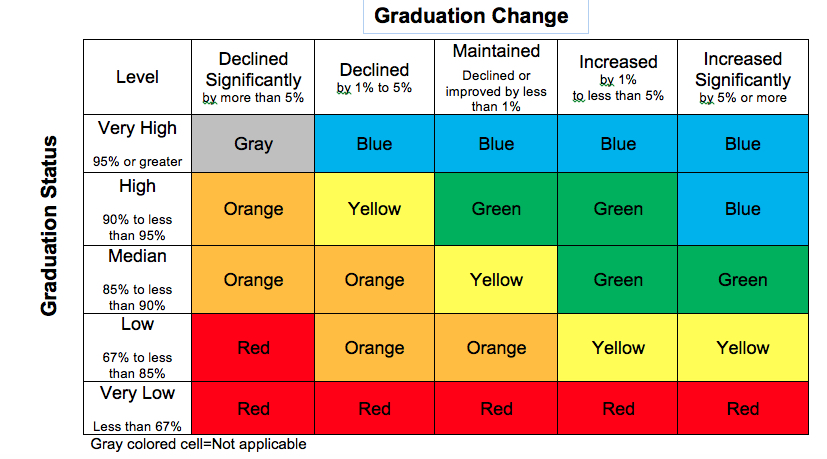State board poised to take new direction in school accountability

CALIFORNIA STATE BOARD OF EDUCATION
The proposed benchmarks for the high school graduation rate indicator show the interplay between the current year’s performance, listed vertically, and the improvement or decline over the past three years. A high school that graduated between 85 and 90 percent of its students in the latest year, in the middle level, could be rated orange (the second lowest ranking) or green (second highest), depending on how much it improved or slipped over the past three years. High schools or districts that rank red would receive technical assistance.
After months of drafting, revising and debating how best to measure and improve schools, the State Board of Education this week will adopt key elements of a new and distinct school accountability system.
The series of votes on Thursday will meet the Legislature’s Oct. 1 deadline and will mark 2½ years since the state board suspended its simpler predecessor, the Academic Performance Index. The board expects to change components of the system in coming years.
The new system shifts from a one-dimensional school rating under the API and the federal No Child Left Behind Act, based on test scores, toward a broader picture of what constitutes a quality education. It combines measures of underlying conditions, such as teacher qualifications and student suspension rates, and academic outcomes, including gauges of college and career readiness and standardized test scores.
A multi-dimensional system that includes some hard-to-quantify measures like school climate is, by nature, complex, and some parent groups and advocates of test-score focused accountability are urging the adoption of a summative ranking, like the API’s numerical rating, that is understandable at a glance.
“As parents and community leaders throughout California, we call on our public officials to give families a clearer school rating system that includes an overall assessment of school quality in addition to the currently proposed multiple measures,” reads a petition that the Los Angeles-based nonprofit Families in Schools is circulating.
The staff of the state board is wrestling with how to display on a one-page report card multiple measures of performance that include an “equity report” with results of subgroups of students. Stung by criticisms of early drafts, the board has farmed out the design to the consulting agency WestEd. A new online display won’t be ready until January.
But unless the federal government forces states to adopt a single rating, the board will use a dashboard of data. The board believes that will better enable the public to understand their schools and hold them accountable. And it will highlight achievement gaps that a single rating would gloss over. “A single number is not sufficient to evaluate an employee or buy a house. Similarly, we shouldn’t depend on just one indicator to understand school performance,” board President Michael Kirstwrote in an EdSource commentary last week.
With multiple measures, the board is following the Legislature’s orders. In the Local Control Funding Formula, legislators set eight priorities that school districts must address. They include implementing academic standards, involving parents in school decisions, creating an engaging school climate and raising student achievement. The Legislature left it up to the board to figure out how to measure progress in all eight priorities, and determine which low-performing districts need help.
That’s the overview. Here are some details; additional information can be found in the board’s agenda.
WHAT WILL THE BOARD ADOPT ON THURSDAY?
Called evaluation rubrics, it’s an accountability tool with several components:
- A set of statewide and district performance indicators measuring the eight priorities identified by the funding formula.
- Benchmarks that define levels of performance by districts, schools and student subgroups for each state indicator. For example, high schools that suspended more than 10 percent of their students last year and failed to reduce their rate over the past three years would be in the lowest level.
- Criteria for determining which low-performing school districts would need technical help from a county office of education and which would State board poised to take new direction in school accountability | EdSource:
